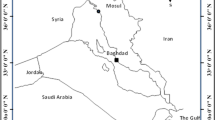Abstract
There are many factors that influence PM10 concentration in the atmosphere. This paper will look at the PM10 concentration in relation with the wet season (north east monsoon) and dry season (south west monsoon) in Seberang Perai, Malaysia from the year 2000 to 2004. It is expected that PM10 will reach the peak during south west monsoon as the weather during this season becomes dry and this study has proved that the highest PM10 concentrations in 2000 to 2004 were recorded in this monsoon. Two probability distributions using Weibull and lognormal were used to model the PM10 concentration. The best model used for prediction was selected based on performance indicators. Lognormal distribution represents the data better than Weibull distribution model for 2000, 2001, and 2002. However, for 2003 and 2004, Weibull distribution represents better than the lognormal distribution. The proposed distributions were successfully used for estimation of exceedences and predicting the return periods of the sequence year.
Similar content being viewed by others
References
Abas, M. R. B., Rahman, N. A., Omar, N. Y. M. J., Maah, M. J., Samah, A. A., Oros, D. R., et al. (2004). Organic composition of aerosol particulate matter during a haze episode in Kuala Lumpur, Malaysia. Atmospheric Environment, 38, 4223–4241.
Corani, G. (2005). Air quality prediction in Milan: feed-forward neural networks, pruned neural networks and lazy learning. Ecological Modelling, 185, 513–529.
Department of Environment, Malaysia (1996). Malaysia environmental quality report 1996. Kuala Lumpur: Department of Environment, Ministry of Sciences, Technology and the Environment, Malaysia.
Department of Environment, Malaysia (2000). Malaysia environmental quality report 2000. Kuala Lumpur: Department of Environment, Ministry of Sciences, Technology and the Environment, Malaysia.
Department of Environment, Malaysia (2001). Malaysia environmental quality report 2001. Kuala Lumpur: Department of Environment, Ministry of Sciences, Technology and the Environment, Malaysia.
Department of Environment, Malaysia (2002). Malaysia environmental quality report 2002. Kuala Lumpur: Department of Environment, Ministry of Sciences, Technology and the Environment, Malaysia.
Department of Environment, Malaysia (2003). Malaysia environmental quality report 2003. Kuala Lumpur: Department of Environment, Ministry of Sciences, Technology and the Environment, Malaysia.
Department of Environment, Malaysia (2004). Malaysia environmental quality report 2004. Kuala Lumpur: Department of Environment, Ministry of Sciences, Technology and the Environment, Malaysia.
Department of Environment, Malaysia (2006). Malaysia environmental quality report 2006. Kuala Lumpur: Department of Environment, Ministry of Sciences, Technology and the Environment, Malaysia.
Evans, M., Hastings, N., & Peacock, B. (2000). Statistical distributions (3rd ed.). New York: Wiley.
Fitri, N. F., Ramli, N. A., & Yahaya, A. S. (2005). Fitting two parameters Weibull distribution function for particulate matter in Penang. In J. M. Jahi, K. Ariffin, A. Awwang, K. Aiyub, & M. R. Razman (Eds.), Prosiding seminar kebangsaan pengurusan persekitaran 2005. Bangi: UKM.
Hitzenberger, R., & Tohno, S. (2000). Black carbon (BC) concentrations and size distributions at two urban sites (Uji, Japan and Vienna, Austria). Journal of Aerosol Science, 31(Suppl), 112–113.
Karaca, F., Alagha, O., & Erturk, F. (2005). Statistical characterization of atmospheric PM10 and PM2.5 concentrations at a non-impacted suburban site of Istanbul, Turkey. Chemosphere, 59, 1183–1190.
Kottegoda, N. T., & Rosso, R. (1998). Statistics, probability and reliability for civil and environmental engineers. Singapore: McGraw-Hill.
Lu, H. C. (2002). The statistical characters of PM10 concentration in Taiwan area. Atmospheric Environment, 36, 491–502.
Lu, H. C. (2003). Estimating the emission source reduction of PM10 in Central Taiwan. Chemosphere, 54(7), 805–814.
Lu, H. C., & Fang, G. C. (2003). Predicting the exceedences of a critical PM10 concentration-a case study in Taiwan. Atmospheric Environment, 37, 3491–3499.
Marcazzan, G. M., Vaccaro, S., Valli, G., & Vecchi, R. (2001). Characterisation of PM10 and PM2.5 particulate matter in the ambient air of Milan (Italy). Atmospheric Environment, 35, 4639–4650.
McBean, E. A., & Rovers, F. A. (1998). Statistical procedures for analysis of environmental monitoring data and risk assessment (pp. 71–72). New Jersey: Prentice Hall PTR.
Mendenhall, W., & Sincich, T. (1994). Statistics for engineering and the sciences. New Jersey: Prentice-Hall.
Meteorological Department (2008). Official website of Malaysia Meteorological Department (MMD); General climate of Malaysia. http://www.met.gov.my/english/education/climate/climate01.html. Accessed 1st February 2008.
Muraleedharan, T. R., Radojevic, M., Waugh, A. & Caruana, A. (2000). Chemical characterization of the haze in Brunei Darussalam during the 1998 episode. Atmospheric Environment, 34, 2725–2731.
Ott, W. R. (1995). Environmental statistics and data analysis. New York: Lewis.
Penang State Government (2008). Official portal of Penang State Government. http://www.penang.gov.my. Accessed 1st February 2008.
Rumburg, B., Alldredge, R., & Claiborn, C. (2001). Statistical distributions of particulates matter and error associated with sampling frequency. Atmospheric Environment, 35, 2907–2920.
Sedek, J. N. M., Ramli, N. A., & Yahaya, A. S. (2006). Air quality predictions using lognormal distribution functions of particulate matter in Kuala Lumpur. Malaysian Journal of Environmental Management, 7, 33–41.
U.S. Environmental Protection Agency(2009). National ambient air quality standard. http://www.epa.gov/air/criteria.html. Accessed 2nd February 2009.
Wang, X., & Mauzerall, D. L. (2004). Characterizing distributions of surface ozone and its impact on grain production in China, Japan and South Korea: 1990 and 2020. Atmospheric Environment, 38, 4383–4402.
Yahaya, A. S., Ramli, N. A., & Yusof, N. F. F. M. (2005). Effects of estimating missing values on fitting distributions. In Proceeding international conference on quantitative Sciences and its applications 2005 (ICOQSIA). Penang.
Author information
Authors and Affiliations
Corresponding author
Rights and permissions
About this article
Cite this article
Md Yusof, N.F.F., Ramli, N.A., Yahaya, A.S. et al. Monsoonal differences and probability distribution of PM10 concentration. Environ Monit Assess 163, 655–667 (2010). https://doi.org/10.1007/s10661-009-0866-0
Received:
Accepted:
Published:
Issue Date:
DOI: https://doi.org/10.1007/s10661-009-0866-0




